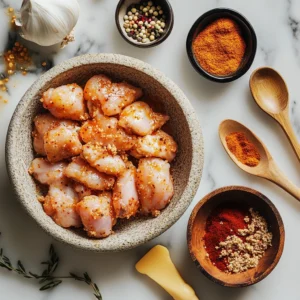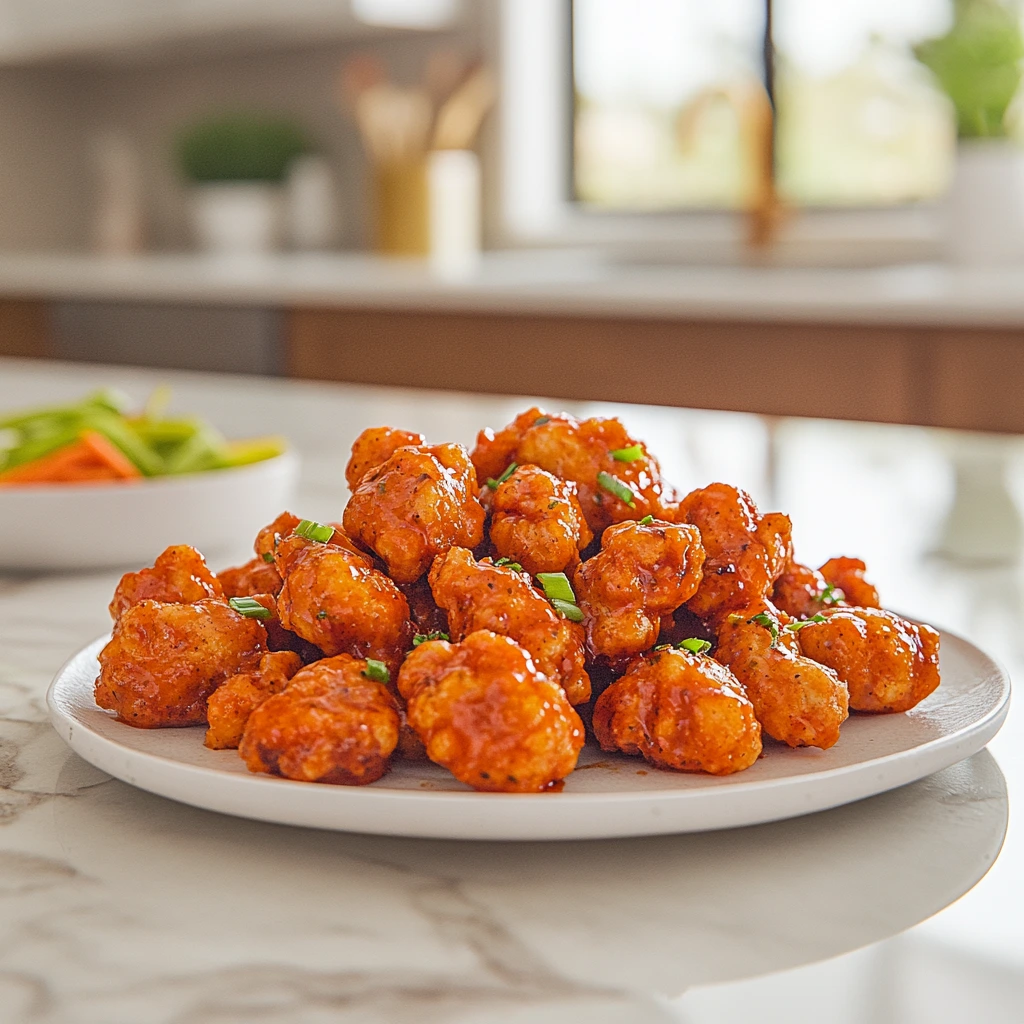Discover the ultimate guide to creating boneless buffalo wings that are not only crispy and spicy but also incredibly versatile and perfect for any occasion.
This detailed article is designed to walk you through every step, from the fascinating history and ingredient selection to cooking techniques and creative serving ideas, ensuring you master a recipe that will impress family and friends. Whether you’re preparing for a game day, hosting a party, or simply craving a delicious snack, this comprehensive guide has you covered.
Introduction
Boneless buffalo wings have taken the culinary world by storm, offering an innovative twist on the traditional wings. Instead of the usual chicken wing sections, these wings are crafted from tender, bite‑sized pieces of chicken breast, making them easier to eat and perfect for a wide range of dipping sauces. In this guide, we will explore the origins of this dish, delve into the best ingredients and equipment, and provide a step‑by‑step breakdown to help you create your own sensational wings. Expect to learn valuable cooking techniques, troubleshooting tips, and creative variations that cater to all tastes and dietary preferences.
For those interested in discovering more about complementary recipes, you might enjoy our Homemade Pancake Recipe for a limited-batch treat, or check out our external resource on classic recipes at Food Network for further inspiration.
History and Origin
The evolution of buffalo wings is as captivating as their flavor profile. Originating in Buffalo, New York, the classic dish made its debut in the mid‑20th century. Over time, its popularity surged, transforming it into a staple of American cuisine. As culinary trends evolved, so did the dish itself, leading to the creation of boneless buffalo wings. These wings use chicken breast pieces instead of the traditional wing sections, offering a less messy and more accessible alternative without sacrificing the spicy, tangy essence of the original.
- Traditional vs. Boneless:
- Traditional wings are typically deep‑fried and tossed in a robust buffalo sauce.
- The boneless version replaces wing meat with chicken breast, providing a leaner, more uniform bite.
- Cultural Impact:
- Initially popularized in sports bars and casual dining spots, the dish has now become a favorite for home cooks and party hosts.
- The shift toward boneless options reflects modern preferences for convenience and versatility in recipes.
Understanding the historical background of this dish not only adds depth to your cooking experience but also enhances your appreciation for its cultural significance.
Ingredients and Equipment
Crafting the perfect boneless buffalo wings recipe begins with carefully selecting quality ingredients and assembling the right tools. Attention to detail during this phase ensures that every bite is packed with flavor and crispiness.
Ingredients
- Chicken:
- Use boneless chicken breasts or tenders. Cut them into evenly sized, bite‑sized pieces for uniform cooking.
- Coating:
- Flour or breadcrumbs (gluten‑free options are available for dietary needs).
- Optional: Cornstarch can be added for an extra crisp layer.
- Seasonings:
- A blend of salt, pepper, garlic powder, paprika, and cayenne pepper to create a flavorful base.
- Adjust seasonings to your taste; for ideas on combining spices effectively, refer to our How to Combine Spices guide.
- Buffalo Sauce:
- Essential ingredients include hot sauce, melted butter, vinegar, and a pinch of salt.
- Customize the heat level to suit your taste preferences, ensuring a perfect balance of spicy and tangy flavors.
Equipment
- Cooking Appliances:
- Deep fryer, air fryer, or conventional oven based on your preferred cooking method.
- Utensils and Tools:
- Mixing bowls, tongs, and a reliable kitchen thermometer to monitor oil temperature and ensure safe cooking.
- A wire rack for draining excess oil when frying, or to use as a surface when baking for enhanced crispiness.
- Additional Items:
- A sharp knife for cutting the chicken. For those seeking to improve their knife skills, our How to Sharpen a Knife article offers practical tips.
Proper preparation of ingredients and having the right equipment sets the stage for a successful cooking experience, making the process both efficient and enjoyable.
Step-by-Step Instructions

Follow these detailed steps to create your own boneless buffalo wings recipe masterpiece. This section is broken down into preparation, various cooking methods, and final assembly to ensure every component of the recipe is perfected.
1. Preparation
- Cutting and Marinating:
- Cut Chicken: Begin by slicing your boneless chicken breasts into uniform, bite‑sized pieces. Consistency in size ensures even cooking.
- Marinate: In a bowl, combine the chicken pieces with salt, pepper, and additional spices. Allow them to marinate for at least 30 minutes. This step is crucial for infusing the meat with deep, flavorful notes.
- Breading/Coating:
- Mix Dry Ingredients: In a separate bowl, combine flour or breadcrumbs with a pinch of garlic powder, paprika, and cayenne pepper.
- Coat the Chicken: Dredge each piece in the dry mixture, ensuring an even coating. Let the coated chicken rest for 10 minutes; this allows the coating to adhere better during the cooking process.
- Bullet Summary:
- Evenly slice the chicken.
- Marinate for a minimum of 30 minutes.
- Coat each piece thoroughly with seasoned flour or breadcrumbs.
2. Cooking Methods
Choose the cooking method that best aligns with your taste and health preferences. Here are three popular methods:
- Deep Frying:
- Preheat oil in a deep fryer or heavy-bottomed pot to 350°F.
- Fry the chicken pieces in small batches for 4-5 minutes until golden and crispy.
- Drain the pieces on paper towels to remove excess oil.
- Oven Baking:
- Preheat your oven to 425°F.
- Arrange the coated pieces on a greased baking sheet or on a wire rack placed over the baking sheet.
- Bake for 15-20 minutes, turning halfway through to ensure even browning.
- Air Frying:
- Preheat the air fryer to 400°F.
- Place the chicken pieces in a single layer in the air fryer basket.
- Cook for 12-15 minutes, shaking the basket halfway to promote even cooking.
- Bullet Comparison:
- Deep frying yields the crispiest texture.
- Oven baking is ideal for larger batches with less oil.
- Air frying offers a healthier alternative while maintaining crunch.
3. Buffalo Sauce Preparation
Creating the perfect buffalo sauce is vital for achieving that classic spicy tang.
- Ingredients for Sauce:
- Combine hot sauce, melted butter, vinegar, and a pinch of salt in a saucepan.
- Cooking Process:
- Heat the mixture over low heat, stirring continuously until the sauce is well blended and slightly thickened.
- Customization Options:
- Add garlic or smoked paprika for an extra layer of flavor.
- For a richer sauce, increase the butter ratio slightly.
4. Assembly and Final Coating
- Tossing the Chicken:
- Place the freshly cooked chicken pieces in a large mixing bowl.
- Drizzle the prepared buffalo sauce over the chicken.
- Toss thoroughly until every piece is evenly coated.
- Final Presentation:
- Arrange the sauced wings on a serving platter.
- Garnish with chopped parsley or green onions for added color and flavor.
- Bullet Summary:
- Cook chicken using your chosen method.
- Prepare and adjust the sauce to taste.
- Toss, coat, and serve with a garnish.
By following these steps carefully, you will achieve a delicious, well-balanced dish that perfectly captures the essence of traditional buffalo wings in a boneless format.
Cooking Techniques and Tips
Mastering the boneless buffalo wings recipe requires not only following a recipe but also understanding the underlying techniques that ensure consistent results. Here are some tips to enhance your cooking process:
- Choosing the Best Cooking Method:
- Deep frying is perfect for achieving an authentic, crispy texture.
- Air frying offers a modern, healthier approach without compromising on crunch.
- Oven baking is excellent for cooking large batches evenly.
- Time-Saving Strategies:
- Pre-mix your marinade and coating mixtures to streamline the process.
- Utilize preheated equipment to reduce overall cooking time.
- Safety and Best Practices:
- Always use a thermometer to monitor oil temperature during frying.
- Avoid overcrowding the pan, as it may lead to uneven cooking.
- Handle hot oil and equipment with caution to prevent accidents.
- Bullet Summary:
- Choose a cooking method based on desired texture and health considerations.
- Pre-prep ingredients and equipment.
- Follow safety guidelines for frying and baking.
For more insightful kitchen practices, you can also explore our Food in the Freezer: Unlock the Unbeatable Benefits for a Brighter Kitchen article.
Tips and Tricks for Perfect Wings
Achieving perfection in your boneless buffalo wings is all about the details. Here are some insider tips and tricks:
- Enhancing Flavor:
- Extend the marination period to allow the chicken to fully absorb all the spices.
- Experiment with spice blends to find the perfect balance—our How to Combine Spices guide is a great resource for creative ideas.
- Maintaining Perfect Texture:
- Ensure the coating is thin and evenly applied.
- Do not overcrowd your cooking surface; give each piece ample space to crisp up.
- Avoiding Common Pitfalls:
- Prevent sogginess by not over-marinating and ensuring the coating sticks properly.
- Use a timer and thermometer to avoid overcooking the chicken.
- Quick Bullet Recap:
- Marinate adequately.
- Apply a uniform, thin coating.
- Cook in small batches.
- Toss immediately in the buffalo sauce for optimum flavor retention.
For more detailed guidance on maintaining sharp kitchen tools, revisit our How to Sharpen a Knife article.
Variations and Adaptations
One of the great aspects of the boneless buffalo wings recipe is its flexibility. You can easily tailor the dish to suit different tastes and dietary needs. Below are some creative variations:
- Sauce Variations:
- Extra-Spicy: Increase the amount of hot sauce or add a dash of cayenne pepper.
- Tangy: Incorporate a splash of lemon juice or vinegar for a zesty kick.
- Sweet and Spicy: Mix in honey or maple syrup to create a balanced flavor profile.
- Dietary Modifications:
- Gluten-Free: Use gluten‑free flour or breadcrumbs for the coating.
- Low-Calorie: Opt for air frying and reduce the amount of butter in the sauce.
- Vegan Adaptations: Substitute chicken with plant-based proteins and use vegan alternatives for butter.
- Fusion Ideas:
- Experiment with an Asian twist by adding soy sauce or sesame oil to the sauce.
- Combine elements from other cuisines to create a unique flavor fusion reminiscent of dishes like Korean fried chicken.
- Bullet Summary:
- Customize the heat, tang, or sweetness of your sauce.
- Adapt ingredients to meet specific dietary requirements.
- Experiment with cultural twists for innovative flavors.
For more creative culinary ideas, you might enjoy our Lobster Pasta Recipe: A Gourmet Seafood Delight which shows how to merge traditional techniques with modern twists.
Serving Suggestions and Dipping Sauces

Elevate your boneless buffalo wings by pairing them with delightful side dishes and dipping sauces. A well-chosen accompaniment not only enhances the flavor of the wings but also creates a more rounded dining experience.
- Ideal Side Dishes:
- Celery and carrot sticks offer a refreshing crunch.
- French fries or potato wedges make a hearty addition.
- Consider a light salad or coleslaw for a balance of textures and flavors.
- Dipping Sauces:
- Classic Blue Cheese: Its creamy tang perfectly complements the heat of the wings.
- Ranch Dressing: A milder option that appeals to those who prefer less intense spice.
- Additional Options: Garlic aioli, spicy mayo, or even a zesty salsa can be excellent choices.
- Presentation Tips:
- Arrange your wings on a colorful platter.
- Garnish with fresh herbs like parsley or chives.
- Serve sauces in separate bowls to allow guests to choose their preferred pairing.
- Bullet Summary:
- Pair wings with crisp vegetables or hearty sides.
- Offer multiple dipping sauces for a customized experience.
- Garnish and present for visual appeal.
For further inspiration on creative dish presentations, explore our Onion Potato Casserole Recipe for ideas on combining textures and flavors.
Nutritional Information and Health Considerations
Enjoying boneless buffalo wings doesn’t mean you have to compromise on health. Understanding the nutritional content and making smart adjustments can help you indulge responsibly.
- Nutritional Breakdown:
- Calories: Vary based on the cooking method and portion size.
- Protein: A great source of lean protein, especially when using chicken breasts.
- Fats: Content depends largely on the amount of oil and butter used.
- Health Tips:
- Choose air frying or oven baking to reduce added fats compared to deep frying.
- Use lean chicken and control salt levels to maintain a balanced diet.
- Pair with nutrient-rich sides such as fresh vegetables or a light salad.
- Bullet Summary:
- Monitor portion sizes.
- Opt for healthier cooking methods.
- Balance indulgence with nutritious sides.
For those looking for further healthy recipe ideas, our Healthy Crockpot Recipes: A Comprehensive Guide offers a wealth of nutritious meal options.

Boneless Buffalo Wings
Equipment
- Mixing bowls
- Knife and Cutting Board
- Tongs
- Wire rack
- Kitchen Thermometer
- Deep Fryer or Air Fryer (Optional)
- Baking Sheet (For Oven Method)
Ingredients
- 2 boneless chicken breasts cut into bite-sized pieces
- 1 cup flour or breadcrumbs for coating
- 2 tablespoons cornstarch optional, for extra crispiness
- 1 teaspoon salt
- 1/2 teaspoon black pepper
- 1/2 teaspoon garlic powder
- 1/2 teaspoon paprika
- 1/4 teaspoon cayenne pepper optional, for extra heat
- 1 cup hot sauce
- 1/4 cup melted butter
- 1 tablespoon vinegar
Instructions
- Cut the boneless chicken breasts into bite-sized pieces for even cooking.
- In a bowl, combine the chicken with salt, pepper, and spices. Let marinate for at least 30 minutes.
- Mix the flour (or breadcrumbs) with garlic powder, paprika, and cayenne pepper in a separate bowl.
- Dredge each chicken piece in the seasoned flour mixture, ensuring an even coating. Let rest for 10 minutes.
- For deep frying: Heat oil to 350°F (175°C). Fry chicken in small batches for 4-5 minutes until golden and crispy. Drain on a wire rack.
- For oven baking: Preheat oven to 425°F (220°C). Arrange coated chicken on a greased baking sheet and bake for 15-20 minutes, flipping halfway.
- For air frying: Preheat to 400°F (200°C). Place chicken in a single layer and air fry for 12-15 minutes, shaking the basket halfway through.
- In a saucepan over low heat, mix hot sauce, melted butter, and vinegar. Stir until smooth and slightly thickened.
- Transfer cooked chicken to a bowl, drizzle buffalo sauce over the pieces, and toss until evenly coated.
- Garnish with chopped parsley or green onions. Serve immediately with ranch or blue cheese dressing.
Notes
Frequently Asked Questions (FAQs)
Below are some of the most common questions regarding our boneless buffalo wings recipe along with concise, helpful answers.
- What is the best way to cook boneless buffalo wings?
- Answer: The optimal method varies based on your preferences:
- Deep frying offers a traditional, crispy texture.
- Air frying provides a healthier alternative while still delivering crunch.
- Oven baking is great for larger batches and even cooking.
- Answer: The optimal method varies based on your preferences:
- How can I achieve a crispy texture without deep frying?
- Answer: Try using an air fryer or baking at a high temperature (425°F) on a wire rack. Ensure that the coating is thin and evenly applied.
- Can I prepare the wings ahead of time?
- Answer: Yes, you can marinate and coat the chicken ahead of time. However, toss with the buffalo sauce just before serving to maintain crispiness.
- What are some popular dipping sauces for these wings?
- Answer: Classic blue cheese, ranch, garlic aioli, and spicy mayo are among the best choices. Adjust the selection based on your spice tolerance.
- How can I adjust the heat level of the buffalo sauce?
- Answer: Increase or decrease the quantity of hot sauce and consider adding milder or more robust spices based on your preference.
Additional tips:
- Always preheat your cooking appliance.
- Use a thermometer to ensure safe and consistent cooking.
- Avoid overcrowding the pan to keep each piece crispy.
Conclusion and Final Thoughts

This extensive guide provides all the insights and techniques you need to master a delectable boneless buffalo wings recipe. From selecting premium ingredients and mastering various cooking methods to exploring creative variations and health-conscious adaptations, every step is designed to ensure that your wings turn out perfectly every time.
- Key Takeaways:
- Preparation: Start with high-quality ingredients, marinate properly, and coat evenly.
- Cooking Methods: Choose the method that best suits your health and texture preferences—deep frying, baking, or air frying.
- Sauce and Assembly: A well-crafted buffalo sauce and immediate tossing are critical for locking in flavor.
- Serving: Complement your wings with a variety of dipping sauces and side dishes for an elevated dining experience.
As you experiment with your own version of this recipe, remember that small adjustments can make a big difference in flavor and texture. Embrace the creative process and feel free to explore new variations—whether it’s a slight twist on the sauce or a different method of cooking, the goal is to enjoy every crispy, spicy bite.
For additional culinary inspiration, consider exploring our Banana Milkshake Recipe: A Comprehensive Guide for a refreshing beverage, or check out our The Best Bisquick Waffle Recipe Guide: Crispy, Fluffy, and Easy for a versatile breakfast option.
By following this guide, you’ll not only create a standout dish that brings together tradition and modern flair but also gain skills that can be applied to many other recipes. Enjoy the journey of cooking and savor every moment spent in the kitchen.
Happy cooking and may your boneless buffalo wings always be crispy, spicy, and full of flavor!

